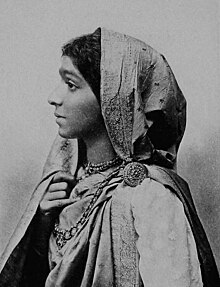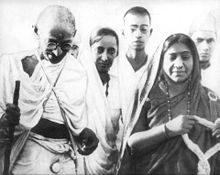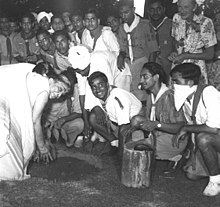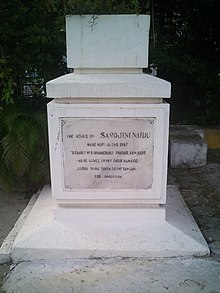| Revision as of 04:58, 7 November 2018 editDajo767 (talk | contribs)Extended confirmed users1,245 edits Undid revision 867659797 by Dajo767 (talk)Tag: Undo← Previous edit | Revision as of 04:58, 7 November 2018 edit undoDajo767 (talk | contribs)Extended confirmed users1,245 editsmNo edit summaryTags: nowiki added Visual editNext edit → | ||
| Line 25: | Line 25: | ||
| }} | }} | ||
| '''Sarojini Naidu'''; '''Chattopadhyay''', (13 February 1879 – 2 March 1949) was an ] independence activist and poet. She was born in a ] ] family at ] and was educated in ], ], and ]. She married Dr. Govindarajulu Naidu and settled down in Hyderabad. She took part in the National Movement, became a follower of Mahatma Gandhi and fought for the attainment of Swaraj. She became the President of Indian National Congress and later she was appointed to the Governor of the United Provinces, now Uttar Pradesh. Known as the 'Nightingale of India',<ref>{{cite web|url=http://www.thehindu.com/children/nightingale-of-india/article19093162.ece|title=NIGHTINGALE of India|accessdate=17 June 2017|publisher=The Hindu|author=Seline Augestine}}</ref> she was also a noted poet. Her poetry includes children's poems, nature poems, patriotic poems and poems of love and death. She also wrote poetry in praise of Muslim figures like Imam Hussain.<ref>{{Cite web|url=http://thewirehindi.com/20108/sarojini-naidu-imam-hussain-dussehra-muharram/|title=सरोजिनी नायडू के इमाम हुसैन को राजनीति ने शिया मुसलमान बना दिया|last=सलीम|first=साकिब|website=thewirehindi.com|language=en-GB|access-date=2018-07-07}}</ref> | '''Sarojini Naidu'''; '''Chattopadhyay''', (13 February 1879 – 2 March 1949) was an ] independence activist and poet. She was born in a ] ] family at ] and was educated in ], ], and ]. She married Dr. Govindarajulu Naidu and settled down in Hyderabad. She took part in the National Movement, became a follower of Mahatma Gandhi and fought for the attainment of Swaraj. She became the President of Indian National Congress and later she was appointed to the Governor of the United Provinces, now Uttar Pradesh. Known as the '''Nightingale of India''<nowiki/>',<ref>{{cite web|url=http://www.thehindu.com/children/nightingale-of-india/article19093162.ece|title=NIGHTINGALE of India|accessdate=17 June 2017|publisher=The Hindu|author=Seline Augestine}}</ref> she was also a noted poet. Her poetry includes children's poems, nature poems, patriotic poems and poems of love and death. She also wrote poetry in praise of Muslim figures like Imam Hussain.<ref>{{Cite web|url=http://thewirehindi.com/20108/sarojini-naidu-imam-hussain-dussehra-muharram/|title=सरोजिनी नायडू के इमाम हुसैन को राजनीति ने शिया मुसलमान बना दिया|last=सलीम|first=साकिब|website=thewirehindi.com|language=en-GB|access-date=2018-07-07}}</ref> | ||
| ==Early life and family== | ==Early life and family== | ||
Revision as of 04:58, 7 November 2018
| Sarojini Naidu | |
|---|---|
| File:Sarojini Naidu in Bombay 1946.jpg | |
| 1st Governor of United Provinces | |
| In office 15 August 1948 – 2 March 1949 | |
| Preceded by | Position established |
| Succeeded by | Hormasji Peroshaw Mody |
| Personal details | |
| Born | Sarojini naidu Chattopadhyay (1879-02-13)13 February 1879 Hyderabad, British India (now India) |
| Died | 2 March 1949(1949-03-02) (aged 70) Lucknow, United Provinces, India |
| Political party | Indian National Congress |
| Spouse | Govindarajulu Naidu(1898–1949) |
| Children | 5; including Padmaja |
| Relatives | Harindranath Chattopadhyay, Virendranath Chattopadhyay, Suhasini Chattopadhyay, Leela Naidu |
| Alma mater | University of Madras King's College London Girton College, Cambridge |
| Occupation | Political activist, poet-writer |
'Sarojini Naidu; Chattopadhyay, (13 February 1879 – 2 March 1949) was an Indian independence activist and poet. She was born in a Bengali Hindu family at Hyderabad and was educated in Chennai, London, and Cambridge. She married Dr. Govindarajulu Naidu and settled down in Hyderabad. She took part in the National Movement, became a follower of Mahatma Gandhi and fought for the attainment of Swaraj. She became the President of Indian National Congress and later she was appointed to the Governor of the United Provinces, now Uttar Pradesh. Known as the Nightingale of India', she was also a noted poet. Her poetry includes children's poems, nature poems, patriotic poems and poems of love and death. She also wrote poetry in praise of Muslim figures like Imam Hussain.
Early life and family
Sarojini was born in a Bengali Hindu family in Hyderabad. Her parental home was at Brahmangaon in Bikrampur (in present-day Bangladesh). Her father, Aghorenath Chattopadhyay, with a doctorate of Science from Edinburgh University, settled in Hyderabad, where administered Hyderabad college, which later became Nizam College in Hyderabad. Her mother, Barada Sundari Devi Chattopadhyay, was a poet and used to write poetry in Bengali.
She was the eldest of the eight siblings. Her brother Virendranath Chattopadhyaya was a revolutionary, and another brother Harindranath was a poet, a dramatist, and an actor.

Sarojini Naidu, having passed her matriculation examination from the University of Madras, took a four-year break from her studies. In 1895, H.E.H. the Nizam's Charitable Trust founded by the 6th Nizam, Mir Mahbub Ali Khan who gave her the chance to study in England, first at King's College London and later at Girton College, Cambridge.
Sarojini met Paidipati Govindarajulu Naidu, a physician, and at the age of 19, after finishing her studies, she married him. At that time, Inter-caste marriages were not as common as they are today, but both their families approved their marriage. The couple had five children. Their daughter Paidipati Padmaja also joined the independence movement and was part of the Quit India Movement. She was appointed the Governor of the State of West Bengal soon after Indian independence.
Political career
| This article may need to be rewritten to comply with Misplaced Pages's quality standards. You can help. The talk page may contain suggestions. (February 2018) |

Naidu joined the Indian national movements in the wake of partition of Bengal in 1905. She came in contact with Gopal Krishna Gokhale, Rabindranath Tagore, Muhammad Ali Jinnah, Annie Besant, C. P. Ramaswami Iyer, Mahatma Gandhi and Jawaharlal Nehru.
In 1915–18, she travelled to different regions in India delivering lectures on social welfare, women's empowerment and nationalism. She also helped to establish the Women's Indian Association (WIA) in 1917. She was sent to London along with Annie Besant, President of home rule league and Women's Indian Association, to present the case for the women's vote to the Joint Select Committee.
In April 1947 she was present at the Asian Relations Conference in Delhi where the Tibetan Government Representative, Sampho Theiji, said, "In a similar way we are very glad to meet representatives from all the Asian countries in this Conference and we wish to express our sincere gratitude to the great Indian leaders, Mahatma Gandhi, Pandit Jawaharlal Nehru and Mrs. Sarojini Naidu, and to all the distinguished representatives who have gathered in this Conference."
Congress Party president
In 1925, Naidu presided over the annual session of Indian National Congress at Cawnpore (now Kanpur).
In 1929, she presided over East African Indian Congress in South Africa. She was awarded the Kaisar-i-Hind Medal by the British government for her work during the plague epidemic in India.

In 1931, she participated in the second round-table conference with Gandhiji and Madan Mohan Malaviya. She was jailed, along with Gandhi, Jawaharlal Nehru, Madan Mohan Malaviya, and others for participating in the Salt March, when 1st Round Table Conference took place in London.
She played a leading role in the Civil Disobedience Movement and was jailed along with Gandhi and other leaders. In 1942, she was arrested during period of the "Quit India Movement"
Sarojini Naidu began writing at the age of twelve. Her Persian play, Maher Muneer, impressed the Nawab of Hyderabad.
In 1905, her first collection of poems, named The Golden Threshold was published. The volume bore an introduction by Arthur Symons. Her poems were admired by prominent Indian politicians like Gopal Krishna Gokhale.
The Feather of The Dawn which contained poems written in 1927 by Naidu was edited and published posthumously in 1961 by her daughter Padmaja Naidu.
Death and legacy

Naidu died of cardiac arrest at 3:30 p.m. (IST) on 2 March 1949 at the Government House in Lucknow. Upon her return from New Delhi on 15 February, she was advised rest by her doctors, and all official engagements were cancelled. Her health deteriorated substantially and bloodletting was performed on the night of 1 March after she complained of severe headache. She died after collapsing following a fit of cough. Naidu was said to have asked the nurse attending to her to sing to her at about 10:40 p.m. (IST) which put her to sleep. The last rites were performed at the Gomati River.
Naidu is commemorated in the names of several institutions, including the Sarojini Naidu College for Women, Sarojini Naidu Medical College, Sarojini Devi Eye Hospital and Sarojini Naidu School of Arts and Communication, University of Hyderabad.
Aldous Huxley wrote "It has been our good fortune, while in Bombay, to meet Mrs. Sarojini Naidu, the newly elected President of the All-India Congress and a woman who combines in the most remarkable way great intellectual power with charm, sweetness with courageous energy, a wide culture with originality, and earnestness with humour. If all Indian politicians are like Mrs. Naidu, then the country is fortunate indeed."
Her 135th birth anniversary (2014) was marked by a Google Doodle on Google India's homepage.
Golden Threshold
Main article: Golden Threshold
The Golden Threshold is an off-campus annexe of University of Hyderabad. The building was the residence of Naidu's father Aghornath Chattopadhyay, the first Principal of Hyderabad College. It was named after Naidu's collection of poetry. Golden Threshold now houses Sarojini Naidu School of Arts & Communication of University of Hyderabad.
During the Chattopadhyay family's residence, it was the centre of many reformist ideas in Hyderabad, in areas ranging from marriage, education, women's. empowerment, literature and nationalism.
Works
Library resources aboutSarojini Naidu
By Sarojini Naidu
Each year links to its corresponding "year in poetry" article:
- 1905: The Golden Threshold, published in the United Kingdom (text available online)
- 1912: The Bird of Time: Songs of Life, Death & the Spring, published in London
- 1917: The Broken Wing: Songs of Love, Death and the Spring, including "The Gift of India" (first read in public in 1915)
- 1916: Muhammad Jinnah: An Ambassador of Unity
- 1943: The Sceptred Flute: Songs of India, Allahabad: Kitabistan, posthumously published
- 1961: The Feather of the Dawn, posthumously published, edited by her daughter, Padmaja Naidu
- 1971:The Indian Weavers
See also
- Indian poetry in English
- Indian English literature
- Indian literature
- List of Indian poets
- List of Indian writers
- Indian poetry
References
- Seline Augestine. "NIGHTINGALE of India". The Hindu. Retrieved 17 June 2017.
- सलीम, साकिब. "सरोजिनी नायडू के इमाम हुसैन को राजनीति ने शिया मुसलमान बना दिया". thewirehindi.com. Retrieved 7 July 2018.
- Lilyma Ahmed. "Naidu, Sarojini". Banglapedia : National Encyclopedia of Bangladesh. Retrieved 5 August 2015.
- ^ "Biography of Sarojini Naidu". PoemHunter.Com. Retrieved 25 March 2012.
- "Padmaja Naidu Dies at 75; ExWest Bengal Governor". The New York Times. Associated Press. 3 May 1975. Retrieved 19 February 2018.
- Pasricha, Ashu (2009). The political thought of Annie Besant. New Delhi: Concept Pub. Co. p. 24. ISBN 978-81-8069-585-8.
- "Asian Relations Conference, 1947 - Legal Materials on Tibet". sites.google.com. Retrieved 18 August 2017.
In a similar way we are very glad to meet representatives from all the Asian countries in this Conference and we wish to express our sincere gratitude to the great Indian leaders, Mahatma Gandhi, Pandit Jawaharlal Nehru and Mrs. Sarojini Naidu, and to all the distinguished representatives who have gathered in this Conference. As for the future, all the Asian countries will feel as brothers towards each other, a feeling based on spiritual relationship, so that in this way we might hope that there will be everlasting peace and unity in Asia.
- Paranjape, Makarand (2013). Making India: Colonialism, National Culture, and the Afterlife of Indian English Authority. New Delhi: Springer Dordrecht Heidelberg New York japan and Amaryllis, an imprint of Manjul Publishing House Pvt., Ltd., New Delhi. p. 190. ISBN 978-94-007-4660-2.
- Jain, Reena. "Sarojini Naidu". Stree Shakti. Retrieved 25 March 2012.
- Sarkar, , Amar Nath Prasad, Bithika (2008). Critical response to Indian poetry in English. New Delhi: Sarup & Sons. p. 11. ISBN 978-81-7625-825-8.
{{cite book}}:|first=has generic name (help)CS1 maint: multiple names: authors list (link) - Nasta, Susheila (16 November 2012). India in Britain: South Asian Networks and Connections, 1858-1950. p. 213. ISBN 978-0-230-39271-7. Retrieved 13 February 2016.
- "Mrs. Sarojini Naidu Passes Away". The Indian Express. 3 March 1949. p. 1. Retrieved 8 February 2018.
- "Last Rites Of Sarojini Naidu At Lucknow". The Indian Express. 4 March 1949. p. 1. Retrieved 8 February 2018.
- Huxley, Aldous (1926). Jesting Pilate: Travels Through India, Burma, Malaya, Japan, China, and America. Paragon House, New York. p. 22.
- "Google Doodle celebrates Sarojini Naidu's 135th Birthday". news.biharprabha.com. Retrieved 12 February 2014.
- "Sarojini Naidu School of Arts & Communication". Retrieved 12 February 2014.
- Sharma, Kaushal Kishore (1 January 2003). "Sarojini Naidu: A Preface to Her Poetry". Feminism, Censorship and Other Essays. Sarup & Sons. pp. 56–57. ISBN 978-81-7625-373-4. Retrieved 13 February 2014.
- Knippling, Alpana Sharma, "Chapter 3: Twentieth-Century Indian Literature in English", in Natarajan, Nalini, and Emanuel Sampath Nelson, editors, Handbook of Twentieth-century Literatures of India (Google books link), Westport, Connecticut: Greenwood Publishing Group, 1996, ISBN 978-0-313-28778-7, retrieved 10 December 2008
- ^ Vinayak Krishna Gokak, The Golden Treasury Of Indo-Anglian Poetry (1828–1965), p 313, New Delhi: Sahitya Akademi (1970, first edition; 2006 reprint), ISBN 81-260-1196-3, retrieved August 6, 2010
- Sisir Kumar Das, "A History of Indian Literature 1911–1956: Struggle for Freedom: Triumph and Tragedy", p 523, New Delhi: Sahitya Akademi (1995), ISBN 81-7201-798-7; retrieved 10 August 2010
- "Jinnah in India's history". The Hindu. 12 August 2001. Retrieved 25 March 2012.
- Lal, P., Modern Indian Poetry in English: An Anthology & a Credo, p 362, Calcutta: Writers Workshop, second edition, 1971 (however, on page 597 an "editor's note" states contents "on the following pages are a supplement to the first edition" and is dated "1972")
- "Indian Weavers". Poem Hunter. Retrieved 25 March 2012.
Further reading
- Gupta, Indra (2004). India's 50 most illustrious women (2nd ed.). New Delhi : Icon Publications.
- Baig, Tara Ali (1985). Sarojini Naidu : portrait of a patriot. New Delhi: Congress Centenary (1985) Celebrations Committee, AICC (I).
- Ramachandran Nair, K. R. (1987). Three Indo-Anglian poets : Henry Derozio, Toru Dutt, and Sarojini Naidu. New Delhi : Sterling Publishers.
Bibliography
- Padmini Sengupta (1997). Sarojini nido.
External links
- The poetry of Sarojini Naidu: A fusion of English language and Indian culture
- Works by Sarojini Naidu at Project Gutenberg
- Works by or about Sarojini Naidu at the Internet Archive
- Works by Sarojini Naidu at LibriVox (public domain audiobooks)

- Biography and Poems of Sarojini Naidu
- Letter written by Sarojini Naidu
- Sarojini Naidu: An introduction to her life, work, and poetry By Vishwanath S. Naravane
- Sarojini Naidu materials at the South Asian American Digital Archive (SAADA)
- Newspaper clippings about Sarojini Naidu in the 20th Century Press Archives of the ZBW
| Indian independence movement | |
|---|---|
| History |
|
| Philosophies and ideologies | |
| Events and movements |
|
| Organisations |
|
| Social reformers |
|
| Independence activists |
|
| British leaders | |
| Independence | |
| Governors of Uttar Pradesh | |
|---|---|
| |
| § Served as governor of United Provinces of Independent India |
- 1879 births
- 1949 deaths
- 20th-century Bengali poets
- People from Hyderabad, India
- Alumni of King's College London
- Alumni of Girton College, Cambridge
- Indian independence activists from Andhra Pradesh
- Indian tax resisters
- English-language poets from India
- Presidents of the Indian National Congress
- Brahmos
- Indian women poets
- Women state governors of India
- People from Bikrampur
- Women in Uttar Pradesh politics
- Indian National Congress politicians from Telangana
- Women in Telangana politics
- Women Indian independence activists
- 19th-century Indian women politicians
- 19th-century Indian politicians
- 20th-century Indian women politicians
- 20th-century Indian politicians
- 19th-century Indian women writers
- 19th-century Indian writers
- 20th-century Indian women writers
- 20th-century Indian poets
- 19th-century Indian poets
- Women writers from Telangana
- Bengali female poets